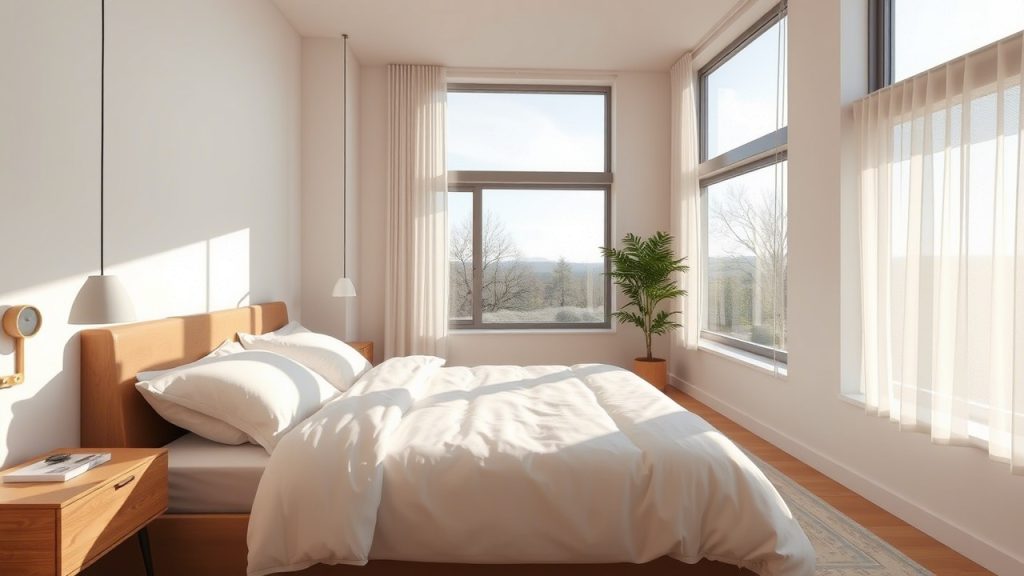Small Bedroom? Best Bed Sizes for Limited Space
When living in a small bedroom, maximizing the available space is crucial. Choosing the right bed size can significantly impact the overall functionality of your room, providing comfort without overcrowding the area. We’ll explore the best bed sizes for small bedrooms, along with tips and suggestions to help you make the most of your limited space.
The Importance of Bed Size in a Small Bedroom
A bed is typically the largest piece of furniture in a bedroom, and in smaller rooms, it often becomes the focal point. If not carefully chosen, the bed can make a small space feel cramped, leaving you with limited room to move around or store your belongings. That’s why selecting the right bed size for a small bedroom is vital.
It’s not just about picking a size that fits; it’s about finding a bed that enhances the room’s functionality while maintaining comfort and style. Let’s take a closer look at the various bed sizes to determine which one works best for a small bedroom.
Common Bed Sizes for Small Bedrooms
When considering a bed for a small bedroom, you have a few options. The standard bed sizes include:
1. Twin Bed (38 x 75 inches)
The Twin bed is often the best option for a small bedroom, especially if the room is intended for a single person. With its compact dimensions, it allows ample space for other furniture like a desk, dresser, or nightstands.
Pros:
- Ideal for rooms under 100 square feet
- Leaves room for other furniture or storage options
- Easy to move and rearrange
Cons:
- Limited space for sleeping, especially for taller individuals
- Not suitable for couples or guests
2. Twin XL Bed (38 x 80 inches)
The Twin XL bed is slightly longer than the regular Twin, providing an extra 5 inches in length. It’s often favored by college students, but it’s also a great option for small bedrooms where a longer bed is needed but space is still limited.
Pros:
- Offers extra length without significantly increasing width
- Works well in rooms where height is more of an issue than width
- Still compact enough for a small bedroom
Cons:
- Like the Twin, it’s a solo sleeper bed, so it’s not ideal for couples
3. Full Bed (54 x 75 inches)
The Full, also known as a double bed, is larger than a Twin, but still relatively compact compared to Queen and King beds. It’s a great choice for someone who wants more space to sleep but doesn’t have a large bedroom.
Pros:
- Provides extra width for more comfort
- Suitable for single sleepers who want more room
- Still relatively small for a compact space
Cons:
- Might feel cramped for couples or taller individuals
- Takes up more space than a Twin or Twin XL
4. Queen Bed (60 x 80 inches)
A Queen bed is one of the most common bed sizes for adults. It’s spacious enough for two people but may be too large for extremely small rooms. However, if your small bedroom is on the slightly larger side, a Queen could still work.
Pros:
- Ideal for couples, providing enough space for two people to sleep comfortably
- Fits in rooms that are around 10 x 10 feet or larger
- Comfortable for taller individuals
Cons:
- Can take up most of the room, leaving little space for other furniture
- Might make the room feel overcrowded in very small spaces
5. King Bed (76 x 80 inches)
While a King bed is the ultimate choice for comfort, it’s generally too large for a small bedroom. However, if you have a room that’s on the larger side of small, and you prioritize comfort over all else, a King bed might be an option.
Pros:
- Extremely spacious, perfect for couples who want maximum comfort
- Ideal for taller people needing more legroom
Cons:
- Takes up a lot of space, leaving little room for anything else
- Not practical for very small rooms
How to Choose the Best Bed Size for Your Small Bedroom
When selecting the right bed size, here are several key factors to consider:
1. Room Size
The size of your room is the most significant factor in determining the best bed size. If you’re dealing with a very small bedroom, such as one under 100 square feet, a Twin or Full bed will likely work best. For rooms around 100-150 square feet, you can consider a Queen bed, but you’ll need to ensure there’s still enough room to move around comfortably.
2. Purpose of the Room
Are you designing a guest bedroom, a child’s room, or your own personal space? For a guest room or children’s bedroom, a Full or Queen might be more appropriate. For a bedroom for one person, especially in a studio apartment, a Twin or Full bed would maximize floor space.
3. Storage Needs
If you need more storage in your small bedroom, consider opting for a bed with built-in drawers or under-bed storage. This can free up space for additional furniture or allow for more efficient organization.
4. Room Layout
Think about how the bed will fit into the layout of the room. A bed placed against the longest wall often works best, but this isn’t always possible, especially with larger bed sizes. Try to create a layout that leaves room for walking paths and ensures the bed isn’t overwhelming the space.
5. Aesthetic Considerations
The style and design of the bed can also impact how it feels in the room. For example, a low-profile bed or a platform bed can create a sense of openness in the room, while a tall, bulky bed frame may make the space feel smaller. Keep these aesthetic factors in mind when making your decision.
Tips for Maximizing Small Bedroom Space
Once you’ve selected the best bed size, it’s time to focus on optimizing the rest of the room. Here are some space-saving tips to make the most of your small bedroom:
1. Use Multi-Functional Furniture
Look for furniture that can serve more than one purpose. A bed with storage drawers or a foldable desk can save valuable space. Murphy beds and wall-mounted desks are great space-saving options as well.
2. Go Vertical
In small bedrooms, you may not have much floor space, so it’s essential to think vertically. Use shelves, wall-mounted lighting, and tall furniture to make use of vertical space. This helps keep the floor area clear, making the room feel more spacious.
3. Keep the Color Scheme Light
Light colors can help make a small room feel larger and airier. Consider using soft neutrals or pastels for walls, bedding, and furniture to create a more open atmosphere.
4. Declutter
One of the easiest ways to make a small room feel more spacious is by keeping it organized and free from clutter. Use bins, baskets, and other storage solutions to keep everything tidy.
5. Consider Furniture Placement Carefully
Try different layouts to find the most efficient use of space. Sometimes placing the bed against a corner or in an unconventional spot can open up more floor space for other furniture and movement.
Frequently Asked Questions
1. What is the best bed size for a small bedroom?
The best bed size for a small bedroom depends on the room’s dimensions. A Twin or Full bed is ideal for rooms under 100 square feet, while a Queen bed works in rooms around 100-150 square feet.
2. How do I know if a Queen bed will fit in my room?
To determine if a Queen bed will fit, measure the available space in your room, leaving room for at least 2 feet of walking space on each side of the bed.
3. Can a King bed fit in a small room?
A King bed typically requires a room size of at least 12 x 12 feet. If your room is smaller than this, a King bed will likely overwhelm the space.
4. What are some space-saving tips for a small bedroom?
Opt for multi-functional furniture, use vertical space with shelves and wall-mounted storage, choose light colors, and declutter the room to maximize available space.
5. What is the difference between a Full and a Queen bed?
A Full bed is 54 inches wide and 75 inches long, while a Queen bed is 60 inches wide and 80 inches long. A Queen bed offers more space for sleeping.
6. Can I fit a bed with storage in a small room?
Yes, beds with built-in storage can be a great solution for small bedrooms, as they maximize space by eliminating the need for additional furniture.
7. Should I go for a low-profile bed in a small room?
A low-profile bed can make a small room feel more open and airy, creating the illusion of more space. It’s a good choice for smaller rooms.
8. What is the smallest bed size?
The smallest standard bed size is a Twin, which is 38 inches wide and 75 inches long. This is ideal for small bedrooms, especially if the room is used by only one person.
9. How can I make a small bedroom look bigger?
Use light-colored paint, choose compact and multi-functional furniture, keep the space uncluttered, and use mirrors to create the illusion of a larger space.
Conclusion
Selecting the best bed size for a small bedroom is about balancing comfort, functionality, and style. By considering factors like room size, layout, and storage needs, you can find the perfect bed to optimize your space. Whether you choose a Twin, Full, or Queen, remember that thoughtful design and clever space-saving solutions can make even the smallest bedroom feel cozy and inviting.





